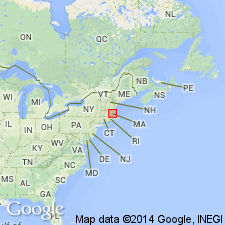
- Usage in publication:
-
- Coal Mine Brook Formation*
- Modifications:
-
- Named
- Dominant lithology:
-
- Slate
- Phyllite
- Arkose
- Conglomerate
- AAPG geologic province:
-
- New England province
Summary:
Fossiliferous slate and phyllite and garnetiferous phyllite, arkose, and conglomerate are here named the Coal Mine Brook Formation at the Worcester coal mine, Worcester, MA. Thicknesses at the composite type localities are 330 m of phyllite, arkose, and conglomerate and 50 m of slate and phyllite. It is separated by faulting and unconformity from the underlying Worcester Formation. Age is Middle Pennsylvanian based on fossil flora found at the coal mine.
Source: GNU records (USGS DDS-6; Reston GNULEX).

- Usage in publication:
-
- Coal Mine Brook Formation*
- Modifications:
-
- Overview
- AAPG geologic province:
-
- New England province
Summary:
Used as Coal Mine Brook of Middle Pennsylvanian age. Consists of fossiliferous, carbonaceous slate and garnet phyllite with a lens of meta-anthracite; conglomerate and arkose.
Source: GNU records (USGS DDS-6; Reston GNULEX).
For more information, please contact Nancy Stamm, Geologic Names Committee Secretary.
Asterisk (*) indicates published by U.S. Geological Survey authors.
"No current usage" (†) implies that a name has been abandoned or has fallen into disuse. Former usage and, if known, replacement name given in parentheses ( ).
Slash (/) indicates name conflicts with nomenclatural guidelines (CSN, 1933; ACSN, 1961, 1970; NACSN, 1983, 2005, 2021). May be explained within brackets ([ ]).

